Chapter 9: Business process change
Chapter learning objectives
Upon completion of this chapter you will be able to:
- explain, for a given organisation, the part business process design can play/did play in an organisation's strategy
- apply Harmon's process-strategy matrix to a given organisation
- explain the commoditisation of business processes and the role of outsourcing
- recommend a business process redesign methodology for an organisation
- evaluate the effectiveness of a current organisational process
- select, from a range of process redesign patterns, feasible options for improving an organisation's processes
- analyse information system requirements
- assess the advantages and disadvantages of package software
- describe how generic solutions can be selected, evaluated and implemented
- describe the relationship between business process redesign and generic software solutions.
1 The role of process and process change initiatives
What is a business process?
 At its most generic, a business process is any set of activitiesperformed by a business that is initiated by an event, transformsinformation, materials or business commitments, and produces an output.
At its most generic, a business process is any set of activitiesperformed by a business that is initiated by an event, transformsinformation, materials or business commitments, and produces an output.
- Value chains and large-scale business processes produce outputs that are valued by external customers.
- Other processes generate outputs that are valued by 'internal' customers and other users.

 More details and historical initiatives
More details and historical initiatives
Processes typically:
- have customers, internal and external
- are independent of formal organisational structure
- may cross organisational boundaries
- should be linked to strategic objectives
- exist in a hierarchy.
Organisations rely on a range of core and support processes to create value for their customers.
- Every business has unique characteristics embedded in its core processes that help it achieve its goals and create competitive advantage.
- Strategic business processes, such as new product design or high-sensitivity customer care, provide unique and durable business advantages to organisations.
- Those processes that depend on people's intelligence, experience, knowledge, judgement and creativity are the hardest for rivals to duplicate.
Historical initiatives
Process change has been a driver of strategic developments for a very long time. Initiatives have included the following:
1903 – Henry Ford
- developed a new manufacturing process for cars and so revolutionised the industry.
1911 – Frederick Taylor published his work on 'scientific management'
- Stressed how processes could be analysed scientifically to determine the best way of performing them and the optimal type of employee for the job.
- He was the forerunner of operational research, work analysis and time-and-motion studies.
1980s – Systems theory
- Systems theory encouraged managers to see how each part of the organisation is connected to other parts, to look at inputs and outputs and to consider linkages within the bigger picture.
1985 – Porter's value chain
Porter's value chain was discussed in detail in chapter 3. Key ideas relevant to this discussion are as follows.
- All activities are seen as being capable of adding value.
- All activities involved with production and all support activities are shown on a single value chain. This ensures that 'big picture' issues such as consistency are considered.
- Activities are emphasised rather than departments. This results in a greater focus on activity based costing and budgeting techniques, for example.
- Linkages between activities are stressed.
1990 – Business Process Reengineering (BPR)
BPR is 'fundamental rethinking and radical redesign of businessprocess to achieve dramatic improvements in contemporary measures suchas cost, quality and speed'.
Key features:
- Managers must consider the bigger picture and how processes affect each other (e.g. a more complex system of management reporting might slow down production).
- Individual processes should be viewed as being integrated into a dozen or so major processes (e.g. a single process might start with the initial order, go through production and product delivery and finish with after-sales customer service).
- IT should be seen as a major tool to improve/streamline/integrate processes.
- Greater customer-focus.
A major problem was the difficulty in integrating IT systems withcorporate processes resulting in some major failures to implementschemes. Add to this employee distrust that BPR simply meant staff cutsit was no surprise that the term fell into disuse during the late 1990s.
Mid 1990s – Software-based initiatives
- Workflow systems software was originally concerned with automating and controlling the flow of electronic documents.
- Enterprise resource planning (ERP) systems developed this idea into representing a wide range of activities as linked modules on diagrams. To some degree, by changing the diagrams managers could control information flow and employee behaviour. These were used with most success in managing accounting, inventory and human resource processes.
- Both workflow systems and ERP approaches had a heavy emphasis on using IT to improve existing processes rather than making radical changes.
- The capability maturity model (CMM) was developed to show the different levels at which organisations use IT to develop processes. Level 5 is the ultimate aim where processes are continuously improved in a systematic way.
Mid 1990s – The Rummler-Brache Methodology
Rummler and Brache produced a framework that showed how different aspects of process development related to each other.
- They defined three levels of performance (organisational, process and job or performer level) and three perspectives (goals and measures, design and implementation, management).
- The CMM model showed how organisations evolve towards maturity and the Rummler-Brache framework showed nine areas that need to be mastered/considered.
Quality based approaches
Quality initiatives (discussed in more detail in chapter 11) andprocess development overlap in many aspects, including the following.
- ISO9000 – the 2000 version stresses the role of quality processes rather than simply the production of documentation to win accreditation.
- Six sigma approaches stress how the success of processes can be measured by focusing on customer satisfaction.

Business process design and strategy
Every organisation wants to improve the way it does business inorder to produce things more efficiently and/or to make greater profits.A change to a business process might lead to a competitive advantage orremove existing competitive disadvantages by either reducing costs ordifferentiating the business.
For example, if a bank can reduce its mortgage approval period from10 days to 1 day, then this could allow the mortgage activity to standout from rivals. In order to achieve this change the bank will have toredesign the approval process (for example, by changing job roles, usingmore efficient IT systems etc.).
In order to determine which processes should be redesigned for apotential competitive advantage we can use Harmon's process-strategymatrix.

 More details on the link to strategy
More details on the link to strategy
If we consider a top-down approach to strategic planning, then thegoals and measures are laid out by the senior managers as theorganisation's strategy.
- Each department or group is assigned only a portion of the corporate goals.
- As the goals are delegated they become narrower and the measures associated with them become more specific.
From the value chain a process is divided into sub processes and sub-sub processes and eventually into specific activities.
- Ideally, one or more measures for each activity are established.
- The measurements determine if the process is working.
When we analyse a process or redesign a process we ask:
- what the activity is contributing to the overall sub process or value chain to which it belongs?
- how can we determine whether the activity is actually achieving its purpose?
Looking at the business in terms of activities and processes opensup scope for challenging the ways in which things are done, and comingup with improvements, or sometimes more radical changes. The approach isoften termed business process improvement or re-engineering, the latterreferring to more radical rethinking. The term 'Business processredesign' is sometimes used as well. The range of opportunities includesthe following:
- if a process is relatively stable and the goal is to make incremental improvements, then the term 'process improvement' is used.
- at the other extreme if a major (core) process needs radical redesigning, then the term 'process re-engineering' is used.
- the term 'process redesign' is used for any processes that fall between these two extremes.
Processes should contribute to the overall strategy of anorganisation and the individual process goals should align with thestrategic goals. For example, if the overall goal of the organisation isto become a quality leader in its respective market, process goals suchas 'shortest execution time' may lead to counter-productive behaviourby process participants who receive incentives for finishing work fast– even if it does not meet the highest quality standards.
Alternatively, the investigation and potential re-design of the wayprocesses take place within an organisation supports the lenses thatJohnson, Scholes and Whittington termed, respectively, experience andideas. An investigation of current processes might suggest that processgoals and measures may not be aligned with strategy. This may be becausethe processes have diverged from their original specification or it maybe because the strategy is not operationally feasible and the peopleundertaking the processes to implement it know this. Consequently,processes are often modified by employees and managers to make themworkable and eventually, strategy is modified to accept this.
The re-design of processes may lead to incremental changes or itmay lead to a significant strategic shift. Opportunities discoveredwhile focusing on specific processes may have very significantrepercussions for strategy.


 Illustration 1 – Henry Ford
Illustration 1 – Henry Ford
The role of process and change initiatives
In 1903 Henry Ford started the Ford Motor Company. He encouragedsimplification, time studies and experimentation to identify the bestway to perform a task. By organising the process as he did, Ford wasable to sell cars at a modest price and pay his workers more than anyother car workers. Ford's success is a great example of the power ofbusiness process change to revolutionise the economics of an industry.

Harmon's process-strategy matrix
According to Paul Harmon a process-strategy matrix is a matrix formed by an estimate of:
- the strategic importance of a process on the horizontal axis
- the process complexity and dynamics on the vertical axis.
This matrix can be used to determined how to manage individual processes.

 Further explanation on Harmon's matrix
Further explanation on Harmon's matrix
Assuming that 'low' is positioned at the bottom left corner:
- processes that fall in the lower-left are of little complexity, do not change very often and do not have much strategic importance. They should be automated if possible and given the minimum resources necessary for efficient functioning
- processes that lie at the upper-right are complex, dynamic and of high strategic importance. These are usually the processes that provide the organisation with its competitive advantage and should be nurtured accordingly.


 Illustration 2 – The role of process and change initiatives
Illustration 2 – The role of process and change initiatives
Applying Harmon's process-strategy matrix to a children's bicyclemanufacturer – Wheelies Co. The management at Wheelies have identifiedthe processes that need to be done.
- New product design.
- Negotiating partnership deals with other organisations.
- On-line purchasing.
- Stock control.
- Credit card approval.
- Bicycle assembly.
- Delivery – international.
- Funds investment.
Now they need to place them on the matrix by deciding how important and how complex the processes are:
- New product designs and negotiating partnership deals are really important and complex – these are the likely candidates for analysing and redesigning.
- Bicycle assembly is not quite as important – a six sigma improvement effort might be introduced to ensure the process is as consistent as possible.
- On-line purchasing is important but routine – this process can be automated quickly and efficiently using off-the-shelf software.
- Stock control and credit card approval are both important but routine and well understood – these processes can be automated quickly and efficiently using off-the-shelf software.
- International delivery is complex but does not add much value and funds investment is important but no one in the company has any expertise in that field – outsourcing these processes is a popular solution.

The commoditisation of business processes and outsourcing
While there is an ongoing trend towards outsourcing in many areas,most organisations view processes as an in-house activity. This has beenfor a number of reasons.
- There is a perceived lack of comparability between the firm's processes and the competences of outside suppliers.
- A lack of standardisation of processes making it difficult to assess whether the process will be improved by outsourcing.
- The high perceived costs of outsourcing compared to the difficult to assess benefits.

 Advantages and disadvantages of BPO
Advantages and disadvantages of BPO
Claimed advantages of BPO include:
- Cost savings (currently the main decision-making factor).
- Improved customer care.
- Allows management to focus on core activities.
Problems seen to date include:
- problems finding a single supplier for complex processes, resulting in fragmentation
- firms are unwilling to outsource whole processes due to the strategic significance or security implications of certain elements
- inflexible contracts and other problems managing suppliers
- problems measuring performance
- data security.
One solution is that some firms have set up shared off-shorecaptive service centres (off-shore in-house rather than off-shoreoutsourced).
In deciding whether to outsource, the following key questions need to be addressed:
(1)What is the desired benefit of outsourcing?
- Cost savings
- To focus on the core business
- To match industry best practice
- To improve service levels.
(2)Which processes should be outsourced?
- Repetitive, transaction-intensive processes are usually the best choices.
(3)How well is the process currently performed?
- Outsourcing a process that currently exceeds competitor benchmarks would be unwise.
Note: the "usual" pros/cons of outsourcing discussed under corporate strategy – cost, quality, control, risk – still apply here.


 Test your understanding 1
Test your understanding 1
Assess which of the following processes is most suitable for outsourcing.
- Environmental reporting.
- Processing online customers' credit card purchases.
- Customer queries and complaints.

2 Improving the processes of an organisation
Process redesign, often called Business Process Re-engineering(BPR), Business Process Management (BPM) or Business Process Improvement(BPI) takes a 'clean sheet' approach to the process, which is usuallyeither broken, or so slow that it is no longer competitive in deliveringthe company's value to its customer.
Business process redesign methodology
Harmon recommends a five-stage generic business process redesign methodology:
Major redesign projects are usually managed by a steering committeeand undertaken by a team that represents all the functional managersinvolved in the change. Other key aspects of project management coveredlater in the syllabus will also be relevant here.
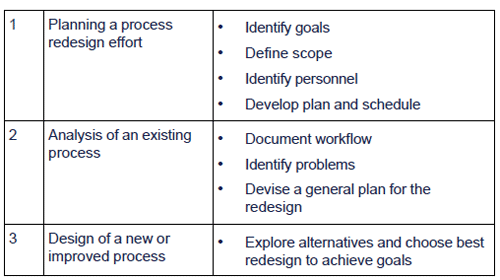


 Illustration 3 – Business Process Redesign
Illustration 3 – Business Process Redesign
Going back to our bicycle manufacturer – Wheelies Co. – we canshow a manufacturing process that starts with three pieces of metal, twoof which are welded together and then joined with the third:
It is clear that there is potential redundancy in the raw materialinspection. If the receiver were to inspect the raw material beforesending it on to the welder or joiner, then they could concentrate ontheir main activities – welding and joining:


 Evaluating effectiveness of a business process
Evaluating effectiveness of a business process
In an exam you may be asked to:
(1)evaluate the effectiveness of an existing process, and
(2)make suggestions for its redesign.
(1)Evaluating the effectiveness of an existing process
You may be given a diagram to analyse for this part of the question.
Diagrams are particularly useful to see who is responsible for whatand it is also easy to start identifying potential inefficiencies andpotential areas of improvement.
- Are there any gaps or steps missing?
- Is there duplication?
- Are there overlaps, where several people or teams perform the same task or activity?
- Are there activities that add no value?
(2)Process redesign solutions
Once the potential areas for improvement have been identified, thenext step is to decide how to address the issues and make changes.
- Diagrams can also be used at this stage to map out the proposed process changes. In an exam, however, you will not be asked to create such diagrams.
- As with any proposed changes in the organisation, the pros and cons need to be analysed, and any changes that follow must be carefully planned.
Range of process redesign patterns
A process redesign pattern is an approach or solution that hasoften worked in the past. There are several patterns that have provedpopular in redesign efforts. For example:
- Re-engineering – start with a clean sheet of paper and question all assumptions.
- Value-added analysis – try to eliminate all non-value-adding activities. Porter's value chain model covered in chapter 3 may be particularly useful here.
- Simplification – try to simplify the flow of the process, eliminating duplication and redundancy.
- Gaps and disconnects – a process redesign pattern that focuses on checking the handoffs between departments and functional groups in order to assure that flows across departmental lines are smooth and effective.
These options can be summarised in the following diagram.
- Towards the left side, the kinds of problems companies face are outlined.
- In the middle, we show a continuum that ranges from Process Improvement to Clean Sheet Design.
- On the right, the ten popular patterns and interventions are shown, roughly aligned to the types of problems they are most commonly used to solve.
Establishing redesign options
An analysis of the range of problems companies face is importantsince it reminds us that different types of problems call for differenttypes of interventions.
- The first key distinction is the distinction between changing existing processes and creating completely new processes.
- A second distinction is the distinction between doing a major redesign of an existing process and simply improving an existing process.
We can improve a process in a number of ways. We can look at it in terms of:
- the process and ask whether we need some steps at all – or whether we can skip them or shortcut them
- where value is added and where the activities involved are wasteful, e.g. any activity that involves storage or waiting in a queue is essentially adding no value and is a target for elimination
- where we might be able to combine or integrate activities, e.g. replacing a machine and a handling operation with one that does both
- starting with a blank sheet of paper and redesigning a way of converting inputs into outputs. This might be relatively simple, e.g. in the paper processing in banking or insurance there may be considerable scope for redesigning and simplifying the route that things take, making sure it is more direct and does not have unnecessary repetition.
This analysis usually results in a number of possible redesignalternatives. In a similar manner to strategy evaluation covered inchapter 6 (suitability, feasibility, acceptability), these redesignoptions need to be evaluated. Options are likely to have varying degreesof feasibility due to such factors as money, culture, effect of change,etc.
Process measures
When new processes are implemented a good management system is thekey to ensuring that the new process is actually implementedeffectively. The management of process activities is concerned with:
- setting goals
- assigning tasks
- monitoring results
- improving processes
- taking corrective action as needed.

3 Software solutions
Establishing business information needs
Various methods are available for establishing business information needs, including the following:
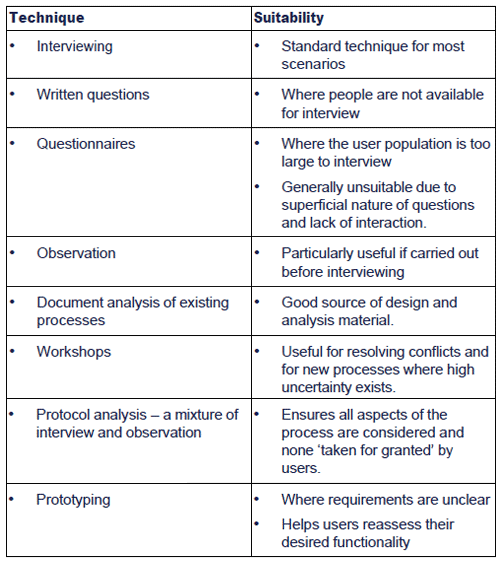
Note: the 'V model' covered later in the syllabus is also relevant here.
Using generic software solutions
There are various ways to produce a software solution.
- Purchase a standard ('generic') software package and:
- use this without any modification
- make suitable amendments to customise this for the organisation's specific requirements
- add company specific modules as necessary.
- Pay for a bespoke system to be developed using existing hardware.
In this section we focus on the use of generic solutions.
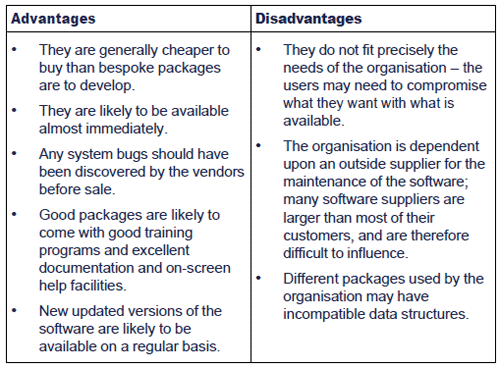
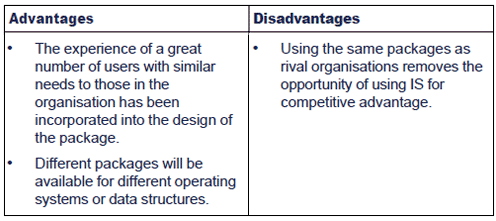
Application packages can be altered and tailored to a buyer'srequirements, but amendments to an existing package have to be paid for,and so add to the purchase cost of the software. In addition, analtered package may not accept the standard updates provided by thesupplier.
Evaluating and selecting a generic software solution
The selection process
- Produce a requirements listing and send this with an invitation to tender to a number of suppliers.
- Review the tender documents and make an initial selection of, say, three software packages.
- Obtain copies of those packages and test on the organisation's own computer system. Alternatively, the supplier may be asked to make a presentation to show why the purchasing company should use their particular package.
- Obtain user input and evaluation of each package.
- Obtain technical input and evaluation of each package to ensure it is compatible where applicable with existing hardware and software and provides the necessary processing capability.
- Test the package with test data from the organisation, paying particular reference to unusual items.
- Provide a final purchase recommendation, taking into account other factors such as after-sales service.
Selection criteria
In evaluating different options, both the software and the supplier need to be assessed. Key factors are thus:


 Evaluating a software purchase
Evaluating a software purchase
There are many points to consider when evaluating possiblepurchases of application software. It is often useful to make out achecklist of the points that are most salient to the user. Some of thepoints that may be included on the checklist are:
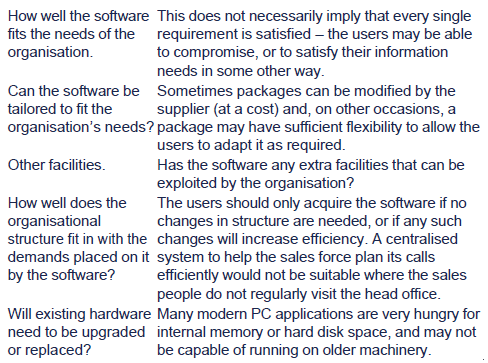



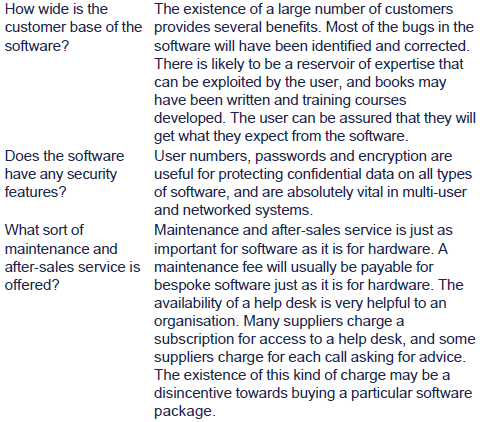


Implementation
Data migration
It is vital to consider the stages that will be addressed during the migration process. Some of the stages include:
- Planning – the organisation may need to create a Steering Committee that has representatives from a number of areas of the organisation including payroll, personnel, etc.; they may be from various levels, e.g. operational, tactical and strategic.
- Data mapping – this is the stage when the data is moved from one system into the field heading and file structures of the new system. An evaluation will need to take place of the structures within the new system and the existing computer system to ensure that the allocation for field headings is consistent.
- Manual input – there may be a requirement to enter some of the data manually from the old format to the new. This will require the organisation to consider the method of manual input as there are many issues with this type of transfer such as the type of input method, e.g. keyboard or scanner. The use of a keyboard, for example, greatly increases the chances of transposition errors that will reduce the quality of the input made.
- Testing the solution – there will need to be a period of testing after the conversion process to ensure that all of the data is accurate and that the system is running properly. A test environment will have to be created by the team to ensure that all the outputs from the tests made are accurate; this may include test plans and scripts for the conversion software.
- Implementing the solution – once the file conversion has been tested and accepted it can be run on the live data. Procedures will have to be specified to test that records are accurately converted.
Training
Training and a strategy for training are crucial. In order for thisto be successful and resources not to be wasted it is vital that thereis clarity about a number of issues. These are:
- Who needs to be trained and why.
- Whether training takes place on or off the job.
- Who will provide the training.
- If training should occur in a short period or be ongoing.
- What the line management involvement will be.

 Methods of training
Methods of training
The chosen approach will depend on organisational structure,company policy and ethos. However, it is important that the approach isclear to the users.
The nature of training that users will require will vary dependent upon:
- User backgrounds.
- Purposes of the system.
- Features of the system.
- The kind of user interfaces – menus, graphics, speech, etc.
Methods of training
A number of alternative training methods are available to theorganisation, but the most important factor to consider is that the typeof training used is matched to the level of experience of the user. Forexample, it would not help an inexperienced user to be presented with amanual; to ensure success the user would need to receive first-handinformation, probably in the form of a taught course. This will alsohelp to improve the acceptance of the new system by the users.
- External courses – this is when the users go to the providers' premises to enable them to obtain the knowledge and the skills to use the new information system.
- Internal courses – the organisation runs a course in-house relating to the use of the information system. The course can be conducted by the internal training or IS department or an external provider may come into the company to teach the course.
- Computer-based training – as an alternative the staff may be trained using a software tutorial that is often supplied with the original software purchase. The tutorial can be quickly installed onto the PC.

Changeover techniques
- Parallel running
This is when the new and the old system run side by side for a period of time, e.g. several weeks, until the analyst is satisfied with the operations of the new information system. It is known as the high-cost low-risk approach.
- Direct changeover
This approach is when the old system immediately finishes and the new takes over; confidence will be high in the new information system. For example, the old finishes at 8.59.59 seconds and the new starts at 9.00.00 seconds. It is known as the high-risk low-cost approach.
- Phased
This is when the new information system can be introduced part by part or stage by stage. This may be useful if the organisation is implementing an information system in a number of departments, as it will help to limit the impacts of the new system. It must be remembered that the phase can be either direct or parallel in each of the stages.

 Test your understanding 2
Test your understanding 2
You are responsible for implementing a payroll system for weeklypaid employees, using a bought-in package on a stand-alone microcomputersystem. There are 3,000 records (one for each employee) in the currentmanual system. Each record is held on a card. The information about eachemployee comprises personal details (personnel number, name, date ofbirth, grade, section, rate of pay, allowances, deductions from pay,etc.), held in the top section of the card. In the body of the card areheld a series of line entries, one for each week of the year. As eachweek is worked the details are entered in the appropriate line: grosspay; tax and national insurance, by reference to the relevant tables;and net pay.
(a)Describe a procedure fortransferring data from the manual to the computer to create the masterfile prior to going live on the new system.
(b)Specify the checks and controls tobe incorporated into the process to ensure that the computerised masterfile is accurate, complete, up to date and suitable for running the livesystem.

Generic software solutions and business process redesign
Competitive advantage
Firms seek to redesign processes to increase their competitiveedge. By using generic software packages they may be able to match thebest practice of competitors who also use the software, but are lesslikely to outperform them.
Note: that there is a tension in the academic texts between thosewho believe that software packages define best practise (e.g. Davenport)and others (e.g. Harmon) who feel they represent average practise.
ERP-driven redesign
As opposed to the BPR approach explained in this chapter, the ERP(Enterprise Resource Planning) -driven approach to software solutionsoccur in reverse order. In effect, businesses start with the solutionand then modify processes.

 Illustration 4
Illustration 4
SAP, the main ERP vendor, provides comprehensive business maps (or'process architectures') for different industries offering a wide rangeof modules covering the processes involved in that industry. Forexample, the insurance business map includes modules for claimsnotification, claims handling, claims accounting, etc. Clients canchoose the modules they require and then specify how they wish to linkthem together and how they wish to control them. The ERP vendor willprovide the underlying workflow engine that passes control from oneprocess to the next.

It is still possible to follow traditional redesign efforts (forexample, by applying Harmon's 5 step process), but, generally, companiestend to accommodate the way that they work around the applicationrather than the other way around.
It can be argued therefore that this approach may be moreappropriate to processes that are not complex. When processes arecomplex, a fundamental redesign process (such as that illustrated inthis chapter) should be used.

 Illustration 5 – Nestlé USA
Illustration 5 – Nestlé USA
In 1997 Nestlé SA saw that its decentralised approach was causingproblems. Operating companies were functioning independently of eachother with little coordination. For example, companies were paying thesame vendor 29 different prices for vanilla, with each company having adifferent coding and name for the vanilla.
Nestlé USA took the decision to standardise software systems usingfive SAP modules – purchasing, financials, sales and distribution,accounts payable and accounts receivable. In addition it would use a SAPsupply-chain management module.
It was found that it was relatively easy to install the SAP modulesbut much harder to change business processes and to win the acceptanceof staff.
Despite costing an estimated $200 million on the transition,Nestlé claims that the project has already paid for itself through:
- More accurate forecasting
- Lower inventory and distribution costs
- Other supply chain improvements
Jeri Dunn (Vice president and CIO of Nestlé USA) commented that if she had to do it again, she would reorder the project:
(1)Focus first on changing business processes
(2)Achieve universal buy-in
(3)Install software
This feedback is typical of firms that rely on ERP applications to drive change, seeing them as the solution rather than tools.

4 Chapter summary
Test your understanding answers

 Test your understanding 1
Test your understanding 1
Environmental reporting is likely to be complex and require greatspecialisation and depth of knowledge so would be difficult to outsource(except to an environmental reporting specialist?)
Processing credit card purchases is high-volume and repetitive sowould appear to be ideal for outsourcing. However, issues ofconfidentiality and data security would need to be met first.
Dealing with customer queries requires detailed product knowledge,which might be lacking. Also there is a high risk of damaging the firm'sreputation and goodwill if complaints are not handled sensitively. Manyfirms who used off-shore call centres to manage customer queries andcomplaints in the 1990s have since brought these services back in-house.


 Test your understanding 2
Test your understanding 2
(a)File conversion takes place duringthe last stages of systems development. Once the new system is in placethen all data has to be transferred onto it. This process can take aconsiderable time when converting from a manual to a computerisedsystem.
The way in which files are converted depends, to some extent,upon their size and complexity. In this case, there are 3,000 recordsfor input onto a stand-alone microcomputer.
Assuming that there is only one input device, presumably a keyboard, the following sequence of events is likely to occur.
- The changeover will be thoroughly planned and a suitable time identified. In the scenario given, it would not be feasible to run any sort of parallel system and as the package being used is a bought-in package, then it will have been tried and tested and will be free from 'bugs'.
- Once a time has been chosen it is necessary to ensure that all the data held within the present system is accurate and up to date. Dead records should be removed from the system.
- The records will be in continuous use, therefore they will have to be entered in batches. Alternatively, all the cards could be photocopied and then entered onto the system.
- Initially, only the static data will be entered on the computer. This includes such data as name, address, personnel record number, etc. A record will be created for each employee containing all his or her personal static data.
- Once the static data has been entered then it will be a relatively easier task to enter the up-to-date variable information. This method avoids data becoming out of date before the system is in operation.
- Once all the data has been transferred to the computer, tests will be carried out using test data to ensure that the system is working correctly.
- Hard copies of all records would be printed out in order for employees to verify their record and also in order to comply with the terms of relevant Data Protection legislation.
- Amendments will be necessary from time to time, as in the case of changes in tax tables and national insurance rates. However, there should be standard programs within the package to facilitate amendment.
(b)Controls that would be incorporatedinto the process to ensure that the computerised master file isaccurate, complete, up to date and suitable for running the live systemwould include the following.
- The controls exercised to check the completeness and accuracy of the existing manual system.
- The controls over the total number of records and the values imposed on certain key fields. Data entry should be controlled by use of a batch register to ensure that all records have been entered.
- Data should be validated by input programs to check correctness of input.
- Strict control should be exercised over any rejected records.
- Notes and records should be kept of any changes to the manual system prior to conversion.
- A check should be made by record once the data has been entered and this should be compared with the manual records.
- A full test run should be initiated in order to check the system's and operator's accuracy.

|
Created at 5/24/2012 12:52 PM by System Account
(GMT) Greenwich Mean Time : Dublin, Edinburgh, Lisbon, London
|
Last modified at 5/25/2012 12:55 PM by System Account
(GMT) Greenwich Mean Time : Dublin, Edinburgh, Lisbon, London
|
|
|
|
 |
Rating
:
|
 Ratings & Comments
(Click the stars to rate the page) Ratings & Comments
(Click the stars to rate the page)
|
 |
Tags:
|
|
|
|
|